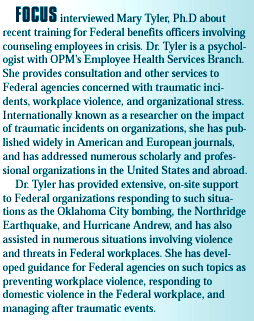 |
 |
 |
 |
Counseling
Employees in
CRISIS'
TRAINING Helps
Agency
Benefits Officers/Customers
 Recently
youíve been involved in efforts to train Federal benefits officers about
counseling employees in crisis. How did this come about?
Recently
youíve been involved in efforts to train Federal benefits officers about
counseling employees in crisis. How did this come about?
I was serving on a Government-wide task force on the response to air disasters involving Federal employees, along with OPM colleagues who specialize in employee benefits. One of the task forceís issues was whether Federal employees are trained to work with people who are bereaved or injured in air crashes. As we thought about it, we realized that the answer was "no," and the problem was even bigger than air crashes.
Agency benefits officers work on a routine basis with people who have lost their spouses, are facing terminal illnesses themselves, are having to retire because of painful medical conditions, and are facing other really difficult circumstances. Their grief or pain may be making it difficult for them to concentrate on the business at hand, and their vulnerability makes it especially important to work with them in a sensitive, compassionate way. But benefits officers, as far as we could tell, were being assigned to work with these very distressed people with no training except on the technical benefits issues. With support from our supervisors, my colleague Ed Chmielowski from OPMís Retirement and Insurance Services and I began working on designing a course to fill the gap.
You mentioned that the format of the course was innovative. Could you tell us more about it?
Our first decision, and probably the most important one we made, was how to structure the course. The easy way would have been to teach the benefits technical part in the morning and the human relations part in the afternoon. But that wouldnít prepare anybody for what they are really going to deal with, which is a human being with a huge tangle of personal pain, family concerns, and unsolved technical questions. And everything is tied together. The size of an annuity isnít just a number; it may be the key to getting kids through college or giving good care to an elderly parent. These are issues that touch our deepest emotions.
Sorting out projected income and working out a budget isnít just a financial exercise; it may give the new widow a big relief from anxiety and the strength to tackle all the other issues she is having to cope with. So Ed and I developed a format for a course co-taught by a benefits specialist and a mental health professional. We co-taught it twice at OPM benefits conferences, and after Ed moved on to another job, his colleague, Ray Kirk, has joined me in teaching it and refining the content.
What kind of situations are Federal benefits officers being prepared for?
The course has four modules: involuntary separation, disability, death, and large scale catastrophes. Each one inter-weaves technical and emotional information. We begin with a discussion of what the issues are on either side of the house, and a list of concrete suggestions for how to deal with them. For example, do have tissues on the table to show itís OK to cry. Donít try to make grief OK with cheerful statements about how it will all work out. Do present information in more than one way ó a list to supplement your discussion. Donít speak of the deceased in an impersonal way, like "the remains."
After we present the information, we move into the case studies, which are really the heart of the course. Each one presents an imaginary Federal employee with his or her own tangle of issues. We use a variety of group exercises like role playing to involve the whole group in empathizing with the employee, sorting out their needs, and bringing information to bear on their problem. At the same time, the benefits officer respects their grief and pain and offers them support.
Does it work?
At first, itís usually the most experienced class members who volunteer to take part in role plays. Pretty soon everybody gets involved, and every-oneís level of comfort and expertise seems to rise. By the end of the day weíre all doing great! A big part of it is helping people recognize the techniques theyíre already using in these situations that are effective. Thatís good for self-confidence. And by focusing very concretely on behavior, we also give them new tools to use. Our course evaluations have been very positive.
Could EAPs be doing more to support benefits officers?
Yes! One concept we really push is that the EAP can be a professional resource to the benefits officer, not just someone to go to with personal problems. EAPs can help them identify referral resources for the clients, whether itís a financial planner or a childrenís grief counselor. And they can talk over cases where the benefits counselor is puzzled by the clientís behavior or unsure about how to approach the person. In some of these very painful cases, just having a place to go for a confidential debriefing can be a real boost for the benefit officerís mental health.
What should the EAP do?
Be proactive. Go to your Human Resources Department and introduce yourself. Find out who does this kind of work and offer your support.